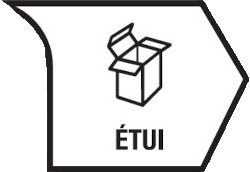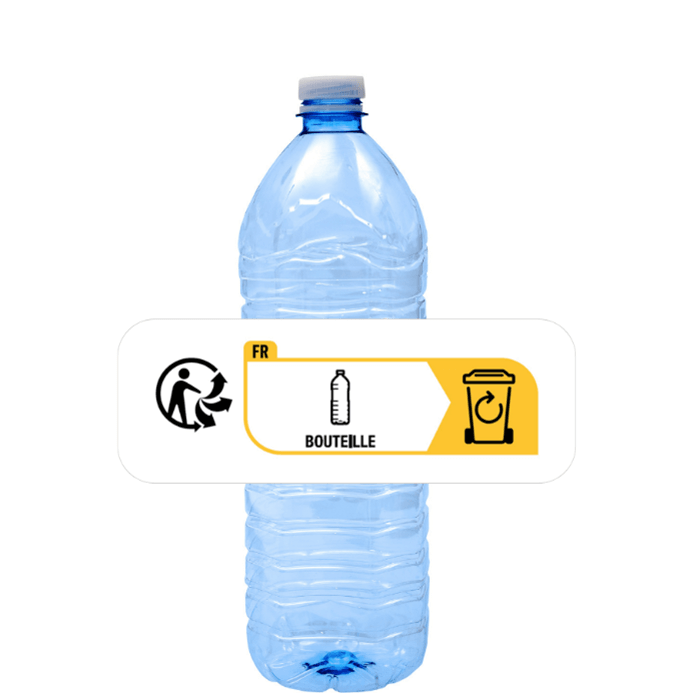Sorting instructions explained to citizens
Ready to become a sorting champion?
Sorting is the act of separating different types of waste and disposing of them in their specific bins.
By respecting it, we can all contribute to a more sustainable and responsible future for our planet.
Sorting your waste is easy!
And Léko will explain a few golden rules.
Selective sorting in France is pretty magical:
ALL household packaging and graphic paper - whatever the material - goes into the yellow sorting garbage can, except glass, which goes into the green glass bin.


The Triman: This official French symbol informs you that the product must be sorted or returned to a collection point. It must appear on the packaging or label of a product that is selectively collected for recycling. So, if you see the Triman on a product, you can be sure that its end-of-life will be taken care of if it's properly sorted!

Packaging elements: These are elements used to protect, transport and store food and non-food products. For example: a lid, a bottle, a cap, a box, a bag, a piece of tape, cushioning elements, etc.
To sort properly, you need to separate all the packaging elements from each other:
- Do not nest them
- Separate each packaging element (lid, tray, lid, etc.)
And then sort them according to the instructions. Sometimes you have a pictogram representing the packaging element, sometimes just a text and sometimes both, depending on the choice of the product producer.


Colors: When it comes to colors on sorting instructions, it's very simple:
- Yellow is for packaging and paper: plastic bottles (which must be capped), cans, tins, cardboard, food cartons and other packaging.
- Green is for glass: bottles, jars, jars... don't forget to remove the caps and lids before throwing them in the green bin.
Destination: This last element tells you very simply where to put the product or packaging element, i.e. either in the "sorting bin" (the yellow garbage can), or in the "glass bin".
Practice!
Move your mouse over a sorting instruction to see which is the best practice to adopt.
Watch out for the traps!

This plastic water bottle of less than 3 liters will go in the sorting bin with its cap.
For food bottles under 3L, it's important to leave the cap on so that it too can be recycled!

This tube and its case go in the sorting bin. As there are 2 elements, it is important to separate them before sorting.

Here, we imagine that the tube in our example has a surface area of between 10 and 20cm2. For this type of packaging, the producer of the product must integrate the Triman and dematerialize its sorting instructions, by putting it on its website for example. For full sorting information on this product, go to the product page on the Internet, where the sorting instructions appear. Generally speaking in France, all household packaging is recyclable and can be sorted in the yellow bin.

This time, we imagine that the tube in our example has a surface area of less than 10cm2. For this type of packaging of less than 10 cm2, the instructions may not be visible. Nevertheless, it is possible to go to the product's Internet page to access the sorting instructions, or to sort it directly into the yellow bin, given that it is household packaging.

For this product, we can identify that there are 3 packaging elements (plastic lid, plastic pot and cardboard packaging). In this case, simply separate the elements and sort them in the sorting bin. This applies to all products with 3 or more packaging elements.

For this glass bottle, with a cardboard case, you need to separate the elements and put them separately in the sorting bin for the case and in the glass bin for the bottle.
We even sort in the bathroom!
It's important to sort waste in every room of the house, including the bathroom. In fact, this room is a real goldmine for sorting! This is where you'll find hygiene and cosmetics products with packaging elements that need to be put in the sorting bin or the glass bin. So don't forget to sort them!

Your questions
But what is household packaging?
Household packaging is a container used to store, transport and protect everyday consumer products for domestic use. It can be a soda bottle, a tube of cream or a bag of cookies.
Household packaging is a ubiquitous part of our daily lives, which is why sorting is so important, as it helps to increase the amount of packaging available for recycling.
Even if I sort, is my packaging really recycled?
It's important to know that recycling is a complex process that depends on many factors, such as the quality of the materials collected, the market demand for these materials, the capacities of sorting and recycling centers, and the waste management policies in your area.
It is therefore possible that certain materials cannot be recycled for a variety of reasons (e.g.: dirty, intermingled, poorly sorted, poorly detected, etc.). That's why it's important to be well-informed about sorting rules and to follow them.
Sorting your household packaging remains an important and necessary action to help reduce waste and preserve the environment. By sorting your packaging, you're doing something positive for the planet and helping to create a more sustainable circular economy.
Which packaging is best recycled in France?
In France, the best recycled packaging is mainly glass, cardboard, steel and aluminum.
Glass is one of the most recyclable materials, and can be recycled ad infinitum without losing its properties. In France, glass bottles and jars are widely collected and recycled into new glass products.
Cardboard is also a highly recyclable material, and is used for the packaging of many products, such as cereals, pasta, drinks, and so on. In France, the recycling rate for cardboard packaging is quite high, thanks to efficient collection and well-equipped sorting centers.
What packaging is not yet recycled in France?
In France, there are still certain types of packaging that are not yet recycled or are recycled on a limited scale. The main ones are :
- Flexible plastic packaging such as sachets, films and plastic bags. Such packaging is difficult to sort and recycle, as it is often contaminated with food residues or other waste, and is often made from a mixture of different plastics.
- Multi-material packaging, such as plastic and aluminum trays or food cartons. These types of packaging are also difficult to recycle, as they are made up of several different materials that have to be separated before they can be recycled.
Neither are bioplastics or biodegradable plastics, which have a different chemical composition to conventional plastics. Indeed, most recycling facilities in France are not equipped to process these types of plastic.
What can I do if my packaging is dirty?
If the packaging is dirty, you can still sort it. However, you need to make sure that it is empty to prevent it from being discarded. It is therefore not necessary to rinse the packaging before sorting.
Can I put all my packaging in my yellow garbage can?
All packaging with the "recycling bin" sorting instruction is sorted in the "yellow garbage can". It's also important to separate packaging items before putting them in the sorting bin.
Do I have to remove corks from plastic bottles or glass jars?
For plastic food bottles of less than 3 liters, leave the cap on the bottle. Otherwise, separate bottle and cap.
There's no need to dispose of glass jars. The recycling plant (glassworks) will take care of it.
Is plastic recyclable?
Yes, plastic is recyclable. However, some types of plastic are easier to recycle than others. That's why it's so important to sort plastic packaging materials correctly, so that they can be recycled efficiently.
From what size are packaging materials sorted at sorting centers?
Generally speaking, the packaging element must be larger than 5 cm x 5 cm for it to be sorted at a French sorting center.
This is because smaller packaging can slip through the sorting machines and be considered as unwanted waste. However, modern sorting centers are increasingly well-equipped to sort smaller and smaller packaging elements.
Which French region sorts best?
Brittany sorts best! In fact, this is the region with the best collection rate for packaging and glass.
However, it should be stressed that this rate depends on many factors, such as population density, the quality of collection, the availability of sorting facilities, and public awareness. Each region therefore has its own specific challenges and opportunities when it comes to waste management and recycling.
Which materials are best captured for recycling in France?
In France, the best recycled packaging is mainly glass, PET bottles, cardboard, steel and aluminum.
Glass is one of the most recyclable materials, and can be recycled ad infinitum without losing its properties. In France, glass bottles and jars are widely collected and recycled into new glass products.
PET bottles (e.g. plastic water bottles) are 98% recyclable. The cap - which, as a reminder, must be on the bottle - and collar are also recycled.
Cardboard is also a highly recyclable material, and is used for the packaging of many products, such as cereals, pasta, drinks, and so on. In France, the recycling rate for cardboard packaging is quite high, thanks to efficient collection and well-equipped sorting centers.
Subscribe
to our newsletter:
to our newsletter:







